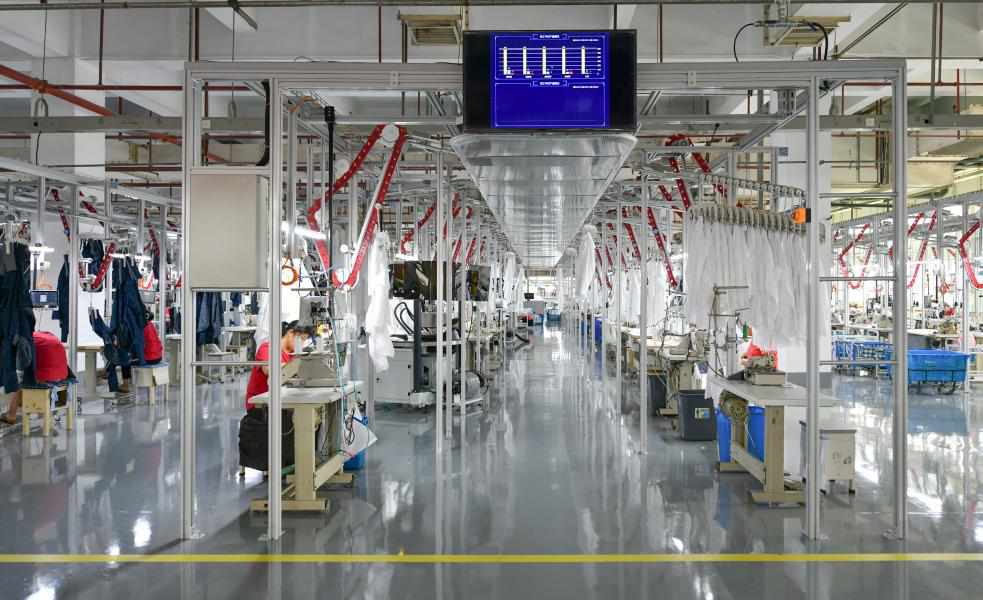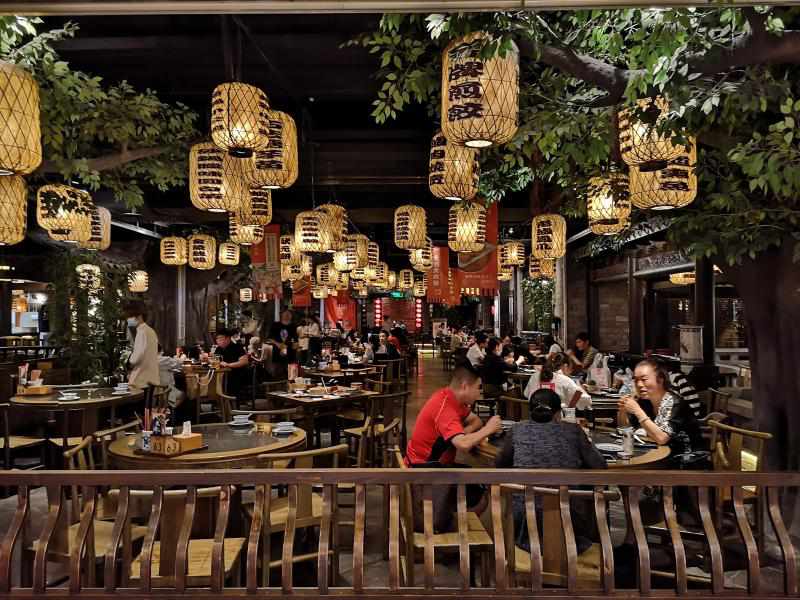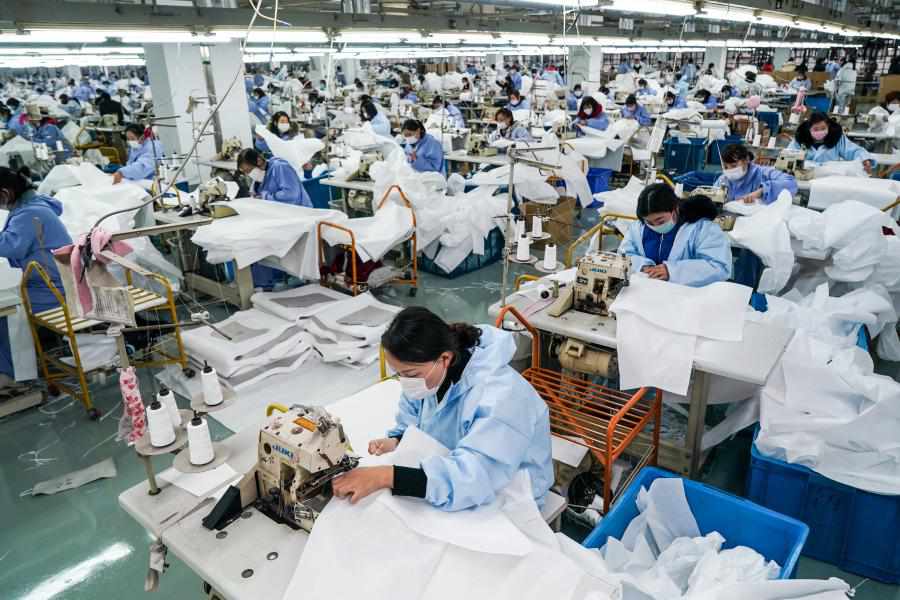

-- China has strengthened its commitment to establishing a development pattern of "dual circulation," in which domestic and overseas markets complement and reinforce each other, with the domestic market as the mainstay.
-- The policy made a big splash in boosting economic rebound. Retail sales of consumer goods, the main gauge of China's consumption, turned from negative growth to positive for the first time this year, with an increase of 0.5 percent year on year in August, data from the National Bureau of Statistics showed.

Photo taken on Aug. 23, 2019 shows an intelligent shirt-making workshop of Hodo Group in Wuxi, east China's Jiangsu Province. (Xinhua)
NANJING, Sept. 24 (Xinhua) -- In a packed mall run by Chinese retail giant Suning Holdings Group in downtown Nanjing, capital of east China's Jiangsu Province, Bao Xunlin finally found a desirable smartphone after carefully comparing the prices.
"The product display is rather tempting, and I've got a much better price with the vouchers," said Bao, a chef in a barbecue restaurant.
The five-story mall resumed both online and offline services on April 30, and the daily sales volume surpassed 200 million yuan (about 29.38 million U.S. dollars) on its opening day, said Ji Liping, vice manager of the mall.
Suning has been managing to buck the trend of global economic recession by digging out the potential of the domestic market, an effort echoing the country's new development pattern of "dual circulation," in which domestic and overseas markets complement and reinforce each other, with the domestic market as the mainstay.
"Our offline sales were greatly affected when the epidemic situation was severe," said Ji. "But we have adopted live streaming and community marketing to attract new customers while tapping the full potential of offline chain stores by optimizing product display and improving services."
Suning's sales volume topped 194 billion yuan in the first half of this year, of which about 134.8 billion yuan came from online sales, up 20.19 percent year on year, the company's financial data showed.
Dual circulation is seen as a strategic and win-win choice for China to reshape its international cooperation and new competitive edge, said renowned economist Justin Yifu Lin, honorary dean of the National School of Development, Peking University.
GROWTH IN CRISIS
The policy made a big splash in boosting economic rebound. Hodo Group, a major apparel manufacturer based in Jiangsu's Wuxi City, registered an export growth of 47 percent in H1 from a year ago, while its profit during the same period soared 110 percent year on year.
"Catering to various customer demands in different countries and time zones, we scheduled 40 live shows each featuring categories such as men's wear and hosiery, which lasted about 12 hours," said Dai Minjun, president of Hodo International Development Co., Ltd, a subsidiary of Hodo Group.
"We could promptly answer customer queries during the live streams, thanks to the multi-language translator," said Dai.
While the COVID-19 pandemic exerted great pressure on the company's production and sales, it blazed a trail by exporting medical supplies, developing new products, and adopting live streaming to tide over the crisis, said Zhou Haijiang, board chairman and CEO of Hodo Group.
Hodo Group is among the large number of Chinese private enterprises that took the initiative to innovate and explore new markets during the pandemic.

People dine at a restaurant in Nanjing, capital of east China's Jiangsu Province, Sept. 16, 2020. (Xinhua/Lu Huadong)
In the workshop of Sierbang Petrochemical in the coastal city of Lianyungang, Jiangsu Province, bags of EVA photovoltaic (PV) materials are being loaded on trucks. They are slated to be delivered to Changzhou, which hosts a number of PV enterprises.
Chinese PV firms used to import the materials from countries such as the Republic of Korea and Thailand, but due to the impact of the pandemic, many turned to domestic suppliers in a bid to resume production.
Sierbang, therefore, strengthened the research and development of related products and increased production output to stabilize the supply chain.
"With steady supply in domestic enterprises, the operation of the entire PV industrial chain has been relatively smooth," said a procurement person at a PV manufacturer.
CONCERTED EFFORTS
Amid the country's efforts to ensure stability on six fronts -- employment, financial sector, foreign trade, foreign investment, domestic investment and expectations -- different departments are strengthening measures to stimulate the vitality of market entities so they not only survive but also thrive.
The provincial government of Jiangsu released a circular in August to boost domestic market sales amid the pandemic, and support foreign trade companies to reduce inventory and recoup losses.

Workers make protective suits at a workshop of Hodo Group in Wuxi, east China's Jiangsu Province, Feb. 8, 2020. (Xinhua/Li Bo)
According to Jiangsu's provincial department of commerce, the province has built 10 national-level cross-border e-commerce pilot areas and established 14 provincial-level overseas warehouses to help trade companies.
"We have set up warehouses in countries like Japan and the United States during the pandemic, and they have not only helped avoid overstock in ports but generated faster delivery of products," said Zhao Mingquan, CEO of a clothing company based in Changshu City.
Jiangsu Nature Biotechnology Co., Ltd., an agricultural company, saw its export revenue exceed 14 million U.S. dollars in H1, up 7.7 million U.S. dollars from last year. "We've received a credit loan worth 7 million yuan that has significantly eased our financial burden," said Fu Baohua, founder of the company, adding that they have exported over 30,000 tonnes of products this year.
Retail sales of consumer goods, the main gauge of China's consumption, turned from negative growth to positive for the first time this year, with an increase of 0.5 percent year on year in August, data from the National Bureau of Statistics showed.
In the first eight months, industrial output expanded 0.4 percent from last year, and fixed-asset investment edged down 0.3 percent year on year, with the decline narrowing from the 1.6-percent in the first seven months.
"Dual circulation will help enterprises establish a flexible industrial chain and form coordination and complementarity between internal and external markets, thus helping develop a resilient, low-risk growth pattern and nurture new growth prospects," said Yang Jijun, vice president of the School of International Economics and Trade, Nanjing University of Finance and Economics.

 Award-winning photos show poverty reduction achievements in NE China's Jilin province
Award-winning photos show poverty reduction achievements in NE China's Jilin province People dance to greet advent of New Year in Ameiqituo Town, Guizhou
People dance to greet advent of New Year in Ameiqituo Town, Guizhou Fire brigade in Shanghai holds group wedding
Fire brigade in Shanghai holds group wedding Tourists enjoy ice sculptures in Datan Town, north China
Tourists enjoy ice sculptures in Datan Town, north China Sunset scenery of Dayan Pagoda in Xi'an
Sunset scenery of Dayan Pagoda in Xi'an Tourists have fun at scenic spot in Nanlong Town, NW China
Tourists have fun at scenic spot in Nanlong Town, NW China Harbin attracts tourists by making best use of ice in winter
Harbin attracts tourists by making best use of ice in winter In pics: FIS Alpine Ski Women's World Cup Slalom
In pics: FIS Alpine Ski Women's World Cup Slalom Black-necked cranes rest at reservoir in Lhunzhub County, Lhasa
Black-necked cranes rest at reservoir in Lhunzhub County, Lhasa China's FAST telescope will be available to foreign scientists in April
China's FAST telescope will be available to foreign scientists in April